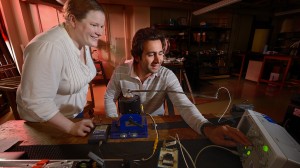
Associate professor of civil engineering Elizabeth Ervin, whose studies include the effect vibrations have on infrastructures, performs a demonstration with graduate student Farhad Sedaghati.
When Elizabeth Ervin joined the University of Mississippi faculty, the associate professor of civil engineering introduced herself as “Shake and Break.”
“My motto is, ‘If you build it, I can break it,'” said the lively researcher who also works with the university’s National Center for Physical Acoustics. “Everything has a natural frequency, which when hit with the right vibration will crumble. My goal is to find those vibrations before they happen and prevent or minimize the structural damage they could later cause.”
Ervin’s studies are not limited to the CE or NCPA laboratories. She and her students have conducted damage research around campus and in the local community. These have included a recent study of the University Avenue overhead bridge that connects Ole Miss to Oxford.
“It’s not easy to determine how much life is left in the bridge, which was built in 1940,” Ervin said. “We found several things that we didn’t like. Based upon our findings, we made recommendations to both the Physical Plant Department and the city of Oxford for ways to improve it. Our goal is to keep our infrastructure healthy and happy, hopefully thereby saving taxpayers’ money.”
Depending on the material being studied, measuring vibrations is time-consuming and expensive.
“We have to locate specifically where the damage is,” Ervin said. “Concrete is very complicated and, therefore, hard to analyze. The mode of failure differs according to the structures and their uses.”
Using her own design, Ervin and her students built a structure for one of her NCPA breakage experiments.
“We used 4,600 pounds of concrete to build a 13-foot-long bridge,” she said. “We’ve been using various frequencies to determine what its breaking point is.”
Factors such as time, weather, rust and natural stress are anticipated when structures are being built. While allowing for inherent flexibility, Ervin looks beyond those things.
“I have to consider what’s not been considered in these building codes as possible causes for structures to fail,” she said. “The strongest building in the world can be knocked down or made to lean just by finding the right vibration.”
Ervin is not just a civil engineer. She also holds degrees in mechanical engineering and uses quite a bit of electrical engineering and computer science.
“I do more programming than anything else,” she said. “But I most enjoy breaking things.”
When not teaching classes or conducting impact and shock experiments, Ervin enjoys travel. She has been to the Galapagos Islands and the Antarctic and Arctic zones.
“I’m determined to see as many places and things as I possibly can,” she said. “The way things are going, one day these won’t be here any longer for people to enjoy.”
A first-generation college graduate, Ervin was born in Millington, Tenn., and reared in a rural area. Encouraged by her father to pursue a formal education, she was in graduate school before she learned she has a learning disorder, which has caused her both stress and success.
“Having a learning disorder makes it easy to get discouraged, but it made me who I am,” Ervin said. “Education is the way you create your future. You have to make a life for yourself.”